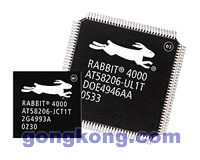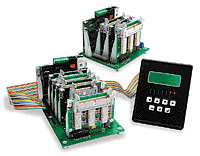Rabbit Day on the Green
2007/9/4 15:12:00
We all know that Tiger belongs on the golf course. But Rabbit?
You better believe it. Broadcast Sports Incorporated, a Maryland-based company that provides wireless cameras for televised sporting events, is using Rabbit Semiconductor Ethernet-enabled RabbitCore microprocessor core modules to control vital camera functions during broadcasts of PGA Masters and Seniors golf tournaments.
"We have 6 to 8 cameras out on any particular event," says Adam Toner, software engineer for Broadcast Sports. "Each camera has a control panel in the production trailer that we take with us, and all of the panels are based around the Rabbit, which interpolates data between the cameras and a central control hub."
The RabbitCores play an essential role in providing clear and consistent images for television audiences watching professional golf on CNBC, CBS, and ESPN. "All control functionality for the broadcast cameras resides in the trailer, so we have got control over things like color balance, gain, shutters, filter—basically, all the functions of a television camera," says Toner. "We have the Rabbits running in the control panels, with Ethernet going out to a central PC—which is in charge of the whole system—and then over a radio link to the cameras that are on the golf course."
Ethernet Broadens Bandwidth
The compact Ethernet RCM2200 was selected to replace the serial-based processor that Broadcast Sports previously employed in its camera systems. "Before, we were using a Motorola MC68HC11 for our serial-based system," says Toner. "The disadvantage of this was the limited communications bandwidth that we could achieve over RS-232-based serial ports. It was also impractical to string more than five or six panels together using serial communications, since each panel requires its own cabling."
The Ethernet-based system that Toner and the design team have now developed is much more practical from a cabling standpoint, providing the necessary bandwidth to string together up to 64 control panels with no loss in performance. "The data from all the panels is multiplexed together and transmitted over a GMSK UHF radio link to control our wireless cameras," says Toner. "Together with the use of a higher speed modem, this allows us to control all of our cameras over a single UHF link where multiple links were previously required. Since clear UHF channels are becoming a rarity at sporting events this is operationally very important to us."
Why Rabbit?
According to design team members, the RCM2200 was a clear choice for the project because of its compact size, built-in Ethernet, and ready-made functionality.
"Off the shelf, it has everything we need," says technician Patrick Curran. "It is tiny, it has tons of memory, and it is easy to incorporate into our existing design."
Toner elaborates: "We wanted our panels to be Ethernet based, and the little RCM2200 boards offer us a nice, compact form factor for a general purpose processor, with all the I/O we need for driving LCD displays, encoders, pushbuttons, and other things," he says. "We pretty much max out the I/O—we just squeezed it all on; I think we have got like one spare pin!"
Price and development time were other key considerations. "The Rabbit low price and the fact that it actually includes the TCP/IP stack [royalty-free] were big things for us," says Toner. "Development was pretty fast, and that was another factor: how quickly we could get up and running. Because the Rabbit is so integrated already, we were able to develop the hardware to go around it very quickly."
Out of the Rough
After using a low-cost RCM2200 Development Kit to evaluate the core module, the engineers built their own hardware around the core module. "We pulled the old processors out of [the existing control panels] and retrofitted them with the Rabbit units," says Toner. "We just made a little adaptor plate and plugged it in the Rabbit module, and that got us going really quickly—within 2-3 weeks we had something running."
Complete system development totaled only about six months. "Overall, I was pretty pleased with the timeframe," says Toner. "We used Rabbit tech support once or twice right at the start, and that was really useful to have them there. But that was just for getting started; once we were up and running, everything went really well."
Programming, meanwhile, was straightforward and swift using Rabbit Dynamic C software development system. "We are using the MicroC/OS-II operating system [included in Dynamic C Premier], which we had used on a couple of other projects," says Toner. "The fact that the real-time kernel is in there and already ported to the Rabbit processor—that helped us out a lot."
After several months of trouble-free service, the new Rabbit-based control system is receiving high marks for performance. "I have been very pleased with the way it all came together," says Toner. "We have been very happy with how the Rabbit worked out in this golf project, and the same system is now being rolled out for other sports, starting with car racing. We may very well end up using the Rabbit in other products—it will certainly be a first choice for anything else that we have coming up."

You better believe it. Broadcast Sports Incorporated, a Maryland-based company that provides wireless cameras for televised sporting events, is using Rabbit Semiconductor Ethernet-enabled RabbitCore microprocessor core modules to control vital camera functions during broadcasts of PGA Masters and Seniors golf tournaments.
"We have 6 to 8 cameras out on any particular event," says Adam Toner, software engineer for Broadcast Sports. "Each camera has a control panel in the production trailer that we take with us, and all of the panels are based around the Rabbit, which interpolates data between the cameras and a central control hub."
The RabbitCores play an essential role in providing clear and consistent images for television audiences watching professional golf on CNBC, CBS, and ESPN. "All control functionality for the broadcast cameras resides in the trailer, so we have got control over things like color balance, gain, shutters, filter—basically, all the functions of a television camera," says Toner. "We have the Rabbits running in the control panels, with Ethernet going out to a central PC—which is in charge of the whole system—and then over a radio link to the cameras that are on the golf course."
Ethernet Broadens Bandwidth
The compact Ethernet RCM2200 was selected to replace the serial-based processor that Broadcast Sports previously employed in its camera systems. "Before, we were using a Motorola MC68HC11 for our serial-based system," says Toner. "The disadvantage of this was the limited communications bandwidth that we could achieve over RS-232-based serial ports. It was also impractical to string more than five or six panels together using serial communications, since each panel requires its own cabling."
The Ethernet-based system that Toner and the design team have now developed is much more practical from a cabling standpoint, providing the necessary bandwidth to string together up to 64 control panels with no loss in performance. "The data from all the panels is multiplexed together and transmitted over a GMSK UHF radio link to control our wireless cameras," says Toner. "Together with the use of a higher speed modem, this allows us to control all of our cameras over a single UHF link where multiple links were previously required. Since clear UHF channels are becoming a rarity at sporting events this is operationally very important to us."
Why Rabbit?
According to design team members, the RCM2200 was a clear choice for the project because of its compact size, built-in Ethernet, and ready-made functionality.
"Off the shelf, it has everything we need," says technician Patrick Curran. "It is tiny, it has tons of memory, and it is easy to incorporate into our existing design."
Toner elaborates: "We wanted our panels to be Ethernet based, and the little RCM2200 boards offer us a nice, compact form factor for a general purpose processor, with all the I/O we need for driving LCD displays, encoders, pushbuttons, and other things," he says. "We pretty much max out the I/O—we just squeezed it all on; I think we have got like one spare pin!"
Price and development time were other key considerations. "The Rabbit low price and the fact that it actually includes the TCP/IP stack [royalty-free] were big things for us," says Toner. "Development was pretty fast, and that was another factor: how quickly we could get up and running. Because the Rabbit is so integrated already, we were able to develop the hardware to go around it very quickly."
Out of the Rough
After using a low-cost RCM2200 Development Kit to evaluate the core module, the engineers built their own hardware around the core module. "We pulled the old processors out of [the existing control panels] and retrofitted them with the Rabbit units," says Toner. "We just made a little adaptor plate and plugged it in the Rabbit module, and that got us going really quickly—within 2-3 weeks we had something running."
Complete system development totaled only about six months. "Overall, I was pretty pleased with the timeframe," says Toner. "We used Rabbit tech support once or twice right at the start, and that was really useful to have them there. But that was just for getting started; once we were up and running, everything went really well."
Programming, meanwhile, was straightforward and swift using Rabbit Dynamic C software development system. "We are using the MicroC/OS-II operating system [included in Dynamic C Premier], which we had used on a couple of other projects," says Toner. "The fact that the real-time kernel is in there and already ported to the Rabbit processor—that helped us out a lot."
After several months of trouble-free service, the new Rabbit-based control system is receiving high marks for performance. "I have been very pleased with the way it all came together," says Toner. "We have been very happy with how the Rabbit worked out in this golf project, and the same system is now being rolled out for other sports, starting with car racing. We may very well end up using the Rabbit in other products—it will certainly be a first choice for anything else that we have coming up."

提交
查看更多评论
其他资讯
Rabbit 4000 微处理器
百信 无线局域网附加开发包
百信 SR9000 Smart Star System
Rabbitcore 工业底板
RabbitSys 嵌入式系统可靠性的解决方案








 投诉建议
投诉建议




